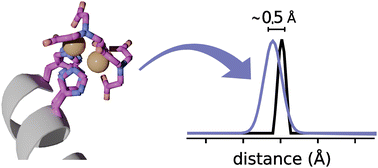Modeling of Cu(ii)-based protein spin labels using rotamer libraries†
Abstract
The bifunctional spin label double-histidine copper-(II) capped with nitrilotriacetate [dHis-Cu(II)-NTA], used in conjunction with electron paramagnetic resonance (EPR) methods can provide high-resolution distance data for investigating protein structure and backbone conformational diversity. Quantitative utilization of this data is limited due to a lack of rapid and accurate dHis-Cu(II)-NTA modeling methods that can be used to translate experimental data into modeling restraints. Here, we develop two dHis-Cu(II)-NTA rotamer libraries using a set of recently published molecular dynamics simulations and a semi-empirical meta-dynamics-based conformational ensemble sampling tool for use with the recently developed chiLife bifunctional spin label modeling method. The accuracy of both the libraries and the modeling method are tested by comparing model predictions to experimentally determined distance distributions. We show that this method is accurate with absolute deviation between the predicted and experimental modes between 0.0–1.2 Å with an average of 0.6 Å over the test data used. In doing so, we also validate the generality of the chiLife bifunctional label modeling method. Taken together, the increased structural resolution and modeling accuracy of dHis-Cu(II)-NTA over other spin labels promise improvements in the accuracy and resolution of protein models by EPR.



 Please wait while we load your content...
Please wait while we load your content...